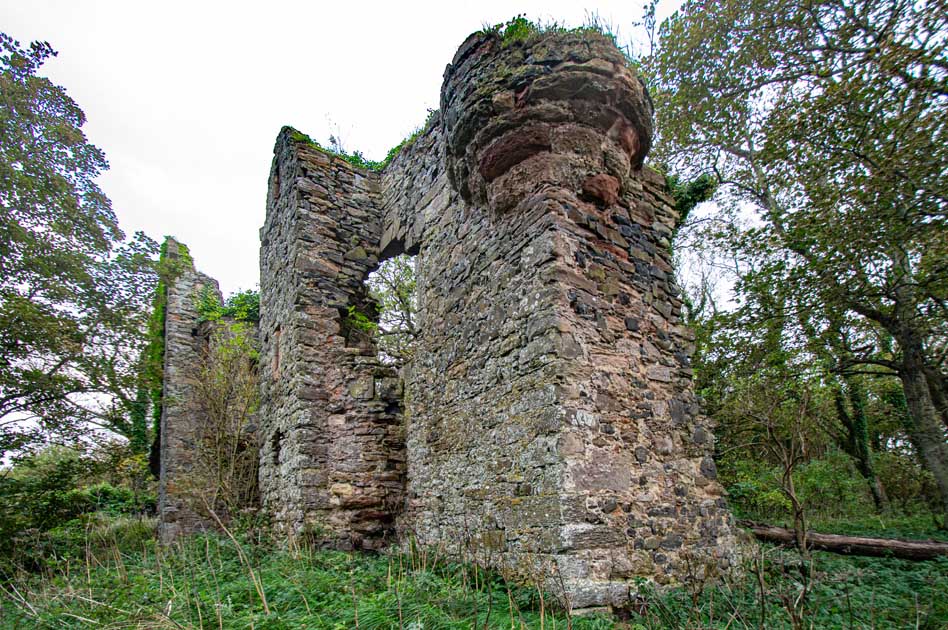Auldhame Castle

Auldhame Castle Details
Auldhame Castle, ruins of C16 tower house of the Otterburns in exposed clifftop site probably dismantled C17
- Closest To: North Berwick, East Linton, Dunbar
- Access: S.O.A.C. Public Access
- Grid Reference: NT602846
Auldhame Castle is a ruined tower house dating most likely to the 16th century and sitting on the top of cliffs just to the south of Tantallon Castle, with good views out to sea and the Bass Rock. The ruin is surrounded by trees, is overgrown, and is accessible down a footpath. The lands of Auldhame were supposedly granted by King Duncan II to Durham Cathedral in 1094 (an unusually early grant, the charter may be a medieval forgery) permitting Durham all rights that the Bishops of St Andrews had held previously. They probably remained in the hands of Durham Cathedral for some time afterwards, associated with Tyninghame Priory which lay to the south. The cove that Auldhame overlooks contains a cave known as “St Baldred’s Cave” and the Priory was dedicated to the same saint. Archaeology has shown that the church at Auldhame fell out of use c1400, and Auldhame next seems to have been a possession of the Home family. George Home of Spott granted some of the lands of Auldhame to Patrick Scougal of that Ilk in 1504, Scougal being less than a mile to the south-east. The Home family also held Tyninghame at this time. In 1518 Adam Otterburn, the king’s advocate and Lord Provost of Edinburgh, starts to appear as “of Auldhame” and his descendants were responsible for the erection of the castle. As early as the 1540s, though, Adam was expressing financial hardship to Cardinal David Beaton. He died of a head injury after being assaulted by one of Arran’s servants in Edinburgh, in July 1548. Adam was succeeded by his eldest son John, who married a daughter of the Earl of Atholl, and John by his son Thomas, who died between 1609 and 1620, leaving his daughter Ann to succeed him. Following what would prove to be an unwise investment in Gorgie Mill, John Otterburn resigned the mill and lands of Auldhame in favour of Thomas and his future wife Marion Cockburn in January 1584. The lawsuit over the mill did not begin until 1605, and lasted into 1609, when the Hamiltons who claimed rights in the mill gave up their case. After this date we do not hear of Thomas again.
The castle survives best on the north-east (seaward-facing) side, which shows that the castle had an impressive frontage on this side. In plan it seems to have been akin to two L-plan tower houses joined together, with the projecting wings facing the sea. The basements were vaulted (and partially survive) and there were two round turrets corbelled out containing stairs. The courtyard extended to the south and west, and the gateway to this survives. The ruin is badly overgrown, and doubtless although the ivy is destructive it holds the building together in places. There were two floors above the basement, and in many ways there are more parallels with an impressive townhouse rather than the tower houses of the countryside. The castle of Auldhame does not appear often in history, and was sold by the Otterburn family to Sir James Suttie (date unknown, but probably circa 1715), who in turn sold it to Oliver Colt of Inveresk. When he died in 1782, he left his widow Auldhame Castle as a dower house, and she lived in it as one of two homes. Auldhame appears regularly on maps up to the middle 19th century, depicted as a large L-shaped building on the clifftop, but it is not known when the building was abandoned or part demolished. The survival of plaster exposed to the elements does suggest it might have become derelict more recently than commonly suspected.
Become a supporter of my work to access a more detailed history
